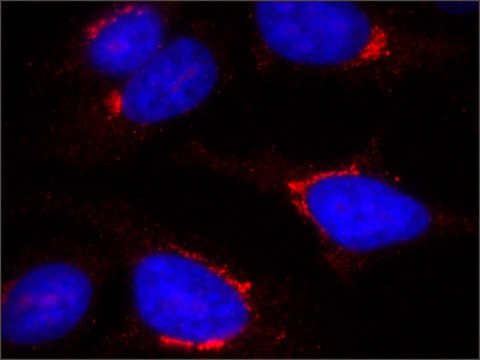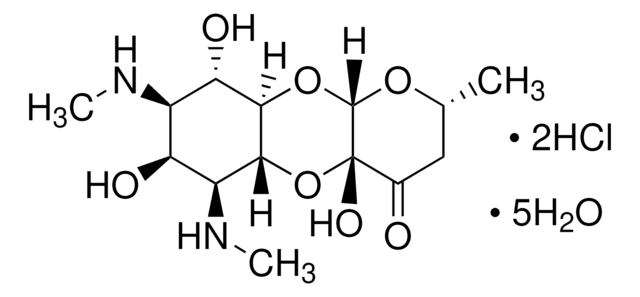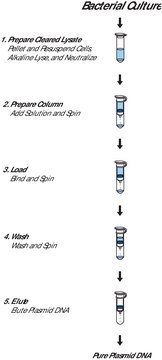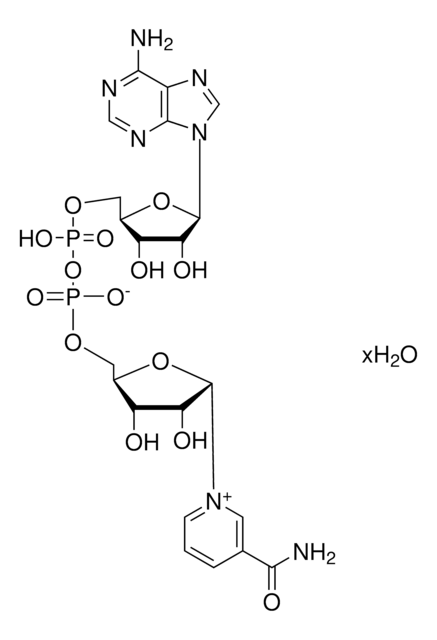Recommended Products
biological source
fish fish (whole)
Quality Level
growth mode
Adherent
karyotype
Not specified
morphology
Fibroblast
products
Not specified
receptors
Not specified
technique(s)
cell culture | mammalian: suitable
shipped in
dry ice
storage temp.
−196°C
Cell Line Origin
Snakehead fish, whole fry tissue
Cell Line Description
E11 is a clone of the cell line SSN-1 and is persistantly infected with a C-type retrovirus (SnRV). It is susceptible to piscine nodavirus strains belonging to different genotypes (SJNNV, RGNNV, TPNNV and BFNNV - striped jack, red spotted grouper, tiger puffer and barfin flounder nervous necosis viruses repectively). E11 is highly permissive to nodavirus infection and production. An advantage of E11, over the parental line SSN-1, is its steady, faster growth to confluency and longer stability in monolayer cultures for 2 weeks at 25 °C or 4 weeks at 20 °C and its reproducible, clear CPE characterised by cytoplasmic vacuole formation followed by intensive disintegration.
Culture Medium
L15 + 5% Fetal Bovine Serum (FBS)+ 2 mM Glutamine
Subculture Routine
Split sub-confluent cultures (70-80%) 1:4, ie., seeding at 3 x10,000 cells/cm2 using 0.05% trypsin/EDTA. No CO2. Culture at 25 °C
Other Notes
Additional freight & handling charges may be applicable for Asia-Pacific shipments. Please check with your local Customer Service representative for more information.
Cultures from HPA Culture Collections and supplied by Sigma are for research purposes only. Enquiries regarding the commercial use of a cell line are referred to the depositor of the cell line. Some cell lines have additional special release conditions such as the requirement for a material transfer agreement to be completed by the potential recipient prior to the supply of the cell line. Please view the Terms & Conditions of Supply for more information.
Depositor and originator: Professor Toshihiro Nakai, PhD Laboratory of Fish Pathology Graduate School of Biosphere Science Hiroshima University 1-4-4 Kagamiyama, Higashi-Hiroshima Hiroshima 739-8528, Japan
For complete product information, please see ECACC
Disclaimer
This cell line has special release conditions: All customers are required to complete a Cell line Release Authorisation form.
WGK
WGK 3
Flash Point(F)
Not applicable
Flash Point(C)
Not applicable
Regulatory Information
新产品
Certificates of Analysis (COA)
Search for Certificates of Analysis (COA) by entering the products Lot/Batch Number. Lot and Batch Numbers can be found on a product’s label following the words ‘Lot’ or ‘Batch’.
Already Own This Product?
Find documentation for the products that you have recently purchased in the Document Library.
Pitchaporn Waiyamitra et al.
Pathogens (Basel, Switzerland), 9(11) (2020-11-12)
Tilapia lake virus (TiLV) causes an emerging viral disease associated with high mortality and economic damage in tilapia farming around the world. The use of probiotics in aquaculture has been suggested as an alternative to antibiotics and drugs to reduce
T Iwamoto et al.
Diseases of aquatic organisms, 43(2), 81-89 (2001-01-06)
Six cell clones were derived from the SSN-1 cell line, which is composed of a mixed cell population and persistently infected with a C-type retrovirus (SnRV). These clones were susceptible to 4 piscine nodavirus strains belonging to different genotypes (SJNNV
Our team of scientists has experience in all areas of research including Life Science, Material Science, Chemical Synthesis, Chromatography, Analytical and many others.
Contact Technical Service




